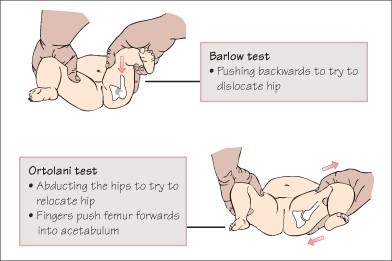The nurse is performing an admission assessment for a newborn who has asymmetrical buttocks. Which assessment test results should the nurse report to the healthcare provider?
Ortolani maneuver causing a click at the hip joint.
Plumb line test indicates fetal position curvature.
Babinski test that reveals fanning out of toes.
Moro test precipitating a startle response.
The Correct Answer is A
The Ortolani maneuver is a physical examination technique used to assess for developmental dysplasia of the hip (DDH) in newborns. During the maneuver, the nurse gently abducts the infant's hips and applies gentle pressure to detect any instability or "click" at the hip joint. A positive Ortolani maneuver, where a click or clunk is felt or heard, can indicate the presence of a hip dislocation or dysplasia.
Asymmetrical buttocks can be a sign of hip dysplasia in newborns, and a positive Ortolani maneuver is an important finding that suggests a potential hip joint problem. Reporting this assessment test result to the healthcare provider allows for further evaluation and appropriate management of the newborn's hip condition.

The Plumb line test, which assesses fetal position curvature, is not directly related to hip dysplasia and may not be significant in this context.
The Babinski test, which reveals fanning out of the toes, is used to assess the integrity of the infant's neurological system and is not specific to hip dysplasia.
The Moro test, also known as the startle response, is a reflex assessment used to evaluate the newborn's neurological and sensory function. While it is important to assess the overall neurological status of the newborn, the Moro test is not specific to hip dysplasia.
Nursing Test Bank
Naxlex Comprehensive Predictor Exams
Related Questions
Correct Answer is D
Explanation
In this scenario, the client is experiencing difficulty falling asleep at night, fatigue, and daytime sleepiness. These symptoms may indicate that the client's exercise routine is impacting their sleep patterns. By asking the client for a description of their exercise schedule, the nurse can gather important information about the timing, intensity, and duration of the client's exercise regimen.
Exercise has numerous benefits for sleep and overall health, but the timing and intensity of exercise can affect sleep patterns differently for individuals. Vigorous exercise close to bedtime may increase alertness and make it harder for some people to fall asleep.
Therefore, understanding the client's exercise routine will help the nurse assess if the timing or intensity of the exercise is contributing to the sleep issues.
Based on the information gathered, the nurse can provide appropriate guidance. This may include adjusting the timing of exercise to earlier in the day, reducing the intensity of exercise closer to bedtime, or considering other factors that may be contributing to the sleep difficulties, such as caffeine intake, stress, or environmental factors.
Correct Answer is ["A","C","D"]
Explanation
A) Correct- This is correct advice. Juice is not recommended for infants due to its high sugar content and lack of essential nutrients. It can contribute to excessive calorie intake and dental caries.
B) Incorrect- This is not accurate for a 9-month-old infant. By 9 months, most infants have already started to transition to solid foods, and their primary source of nutrition should be from a variety of solid foods, not formula.
C) Correct- This is correct advice. By 9 months, infants can begin to consume a variety of complementary foods to meet their nutritional needs. Adding raw fruit, cheese, or cooked vegetables can provide important nutrients and help introduce different tastes and textures.
D) Correct- As infants transition to solid foods, they typically require more frequent meals and snacks to meet their energy and nutrient needs. Breast milk or formula intake may also gradually decrease as solid foods are introduced.
E) Incorrect- Fluoride supplementation may be considered based on the fluoride content of the water supply and the child's risk of dental caries. However, this advice is not specific to the child's nutrition and feeding progression.
F. Incorrect- At 9 months, infants should not transition to whole cow's milk as their main source of nutrition. Breast milk or infant formula remains the primary source of nutrition, and cow's milk can be introduced as a beverage and ingredient in cooking after the first year of life.
Whether you are a student looking to ace your exams or a practicing nurse seeking to enhance your expertise , our nursing education contents will empower you with the confidence and competence to make a difference in the lives of patients and become a respected leader in the healthcare field.
Visit Naxlex, invest in your future and unlock endless possibilities with our unparalleled nursing education contents today
Report Wrong Answer on the Current Question
Do you disagree with the answer? If yes, what is your expected answer? Explain.
Kindly be descriptive with the issue you are facing.
